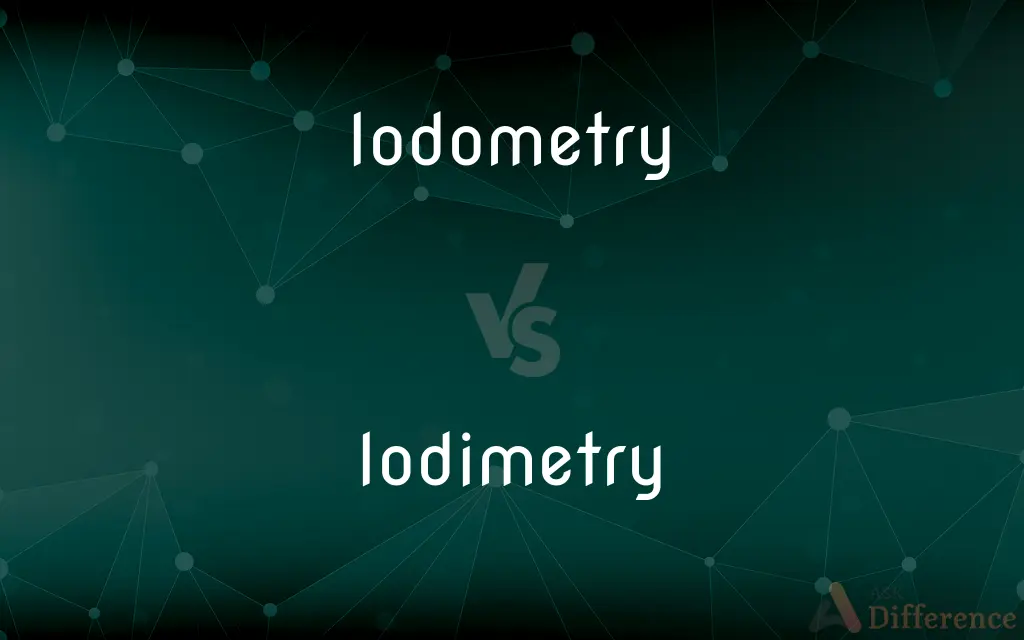Iodometry vs. Iodimetry — What's the Difference?
Edited by Tayyaba Rehman — By Fiza Rafique — Updated on September 24, 2023
Iodometry involves the use of iodine indirectly as it forms during a reaction, while Iodimetry directly utilizes iodine in its titration.

Difference Between Iodometry and Iodimetry
Table of Contents
ADVERTISEMENT
Key Differences
Iodometry and Iodimetry are both quantitative analytical techniques used in chemistry. Iodometry measures the amount of iodine indirectly. In this technique, a species releases iodine, which is then titrated. In contrast, Iodimetry uses iodine directly, where it is the titrating agent reacting with an analyte.
In Iodometry, the substance being analyzed typically undergoes a reaction producing iodine. For instance, when an oxidizing agent reacts with iodide ions, iodine gets formed. This iodine is then titrated using a reducing agent. On the other hand, in Iodimetry, iodine reacts with a reducing agent or another substance that can be oxidized.
The name Iodometry derives from the process where iodine measurement happens indirectly through its formation. The iodine formed is then titrated typically with sodium thiosulfate. Conversely, Iodimetry is more straightforward, where the iodine itself directly participates in the titration process.
To put it simply, while both Iodometry and Iodimetry revolve around the use of iodine in analytical chemistry, their main distinction lies in how iodine is employed in each method. Iodometry is an indirect process concerning iodine's formation and subsequent measurement, while Iodimetry is a direct method using iodine itself in the titration.
Comparison Chart
Utilization of Iodine
Indirectly (formed during reaction)
Directly
ADVERTISEMENT
Reaction Partner
Usually an oxidizing agent
Typically a reducing agent
Titration Process
Involves titration of produced iodine
Involves direct reaction with iodine
Typical Titrant Used
Sodium thiosulfate
Depends on the substance being analyzed
Analytical Context
Measures released iodine from a chemical reaction
Measures by directly using iodine in titration
Compare with Definitions
Iodometry
A technique in which the endpoint is detected by the disappearance of iodine color.
The blue to colorless transition is a common endpoint in Iodometry.
Iodimetry
The technique where iodine acts as the titrating agent.
Iodimetry can analyze substances that directly react with iodine.
Iodometry
It involves titrating iodine produced from a reaction.
In Iodometry, iodides react with oxidizing agents to produce iodine.
Iodimetry
A method based on the oxidizing properties of iodine.
Iodimetry is a popular method for water treatment analysis.
Iodometry
An analytical method where iodine is measured indirectly.
In Iodometry, the quantity of chlorine in bleach can be determined.
Iodimetry
A titration method using iodine directly.
In Iodimetry, iodine is directly used to titrate vitamin C solutions.
Iodometry
Focuses on oxidizing agents reacting with iodide ions.
In Iodometry, a copper(II) solution can be analyzed with sodium thiosulfate.
Iodimetry
Involves a direct reaction between iodine and an analyte.
Sulfites can be determined by direct titration using Iodimetry.
Iodometry
Often associated with volumetric analyses in chemistry.
Vitamin C concentration can be determined using Iodometry.
Iodimetry
It provides a quantitative analysis of reducing agents.
Thiosulfates can be measured effectively using Iodimetry.
Iodometry
Iodometry, known as iodometric titration, is a method of volumetric chemical analysis, a redox titration where the appearance or disappearance of elementary iodine indicates the end point. Note that iodometry involves indirect titration of iodine liberated by reaction with the analyte, whereas iodimetry involves direct titration using iodine as the titrant.
Iodimetry
(chemistry) titration in order to quantitatively analyze iodine in a sample
Iodometry
(chemistry) An analytical technique that uses the sudden disappearance (or appearance) of iodine to mark the end of a redox titration
Common Curiosities
And Iodimetry?
Iodimetry involves direct titration using iodine.
How is the endpoint usually detected in Iodometry?
In Iodometry, the endpoint is often detected by the disappearance of the iodine color.
What is a common titrant in Iodimetry?
In Iodimetry, the titrant is typically iodine itself.
Is Iodimetry more straightforward than Iodometry?
In terms of iodine usage, Iodimetry is more direct, while Iodometry measures iodine indirectly.
What does Iodometry measure?
Iodometry measures iodine indirectly, which forms during a reaction.
Can Iodometry be used for vitamin C analysis?
Yes, Iodometry can determine vitamin C concentration by titrating the iodine produced.
Do both methods involve iodine?
Yes, both Iodometry and Iodimetry revolve around the use of iodine, but in different contexts.
Which method often relates to the oxidizing properties of iodine?
Iodimetry is based on the oxidizing properties of iodine.
Is the iodine color transition relevant in both methods?
The iodine color transition is particularly significant in Iodometry for detecting the endpoint.
Can Iodimetry be used for water analysis?
Yes, Iodimetry is a popular method for analyzing certain compounds in water treatment.
Why is sodium thiosulfate commonly used in Iodometry?
In Iodometry, sodium thiosulfate is used as it effectively titrates the iodine produced.
How is iodine directly used in Iodimetry?
In Iodimetry, iodine acts as the titrating agent, reacting directly with an analyte.
Which method, Iodometry or Iodimetry, involves iodine forming during a reaction?
Iodometry involves iodine forming during a reaction.
Which method is commonly associated with volumetric analyses?
Iodometry is often associated with volumetric analyses in chemistry.
Can I use Iodimetry to analyze reducing agents?
Yes, Iodimetry provides a quantitative analysis of reducing agents.
Share Your Discovery

Previous Comparison
Concern vs. Complaint
Next Comparison
Actor vs. ComedianAuthor Spotlight
Written by
Fiza RafiqueFiza Rafique is a skilled content writer at AskDifference.com, where she meticulously refines and enhances written pieces. Drawing from her vast editorial expertise, Fiza ensures clarity, accuracy, and precision in every article. Passionate about language, she continually seeks to elevate the quality of content for readers worldwide.
Edited by
Tayyaba RehmanTayyaba Rehman is a distinguished writer, currently serving as a primary contributor to askdifference.com. As a researcher in semantics and etymology, Tayyaba's passion for the complexity of languages and their distinctions has found a perfect home on the platform. Tayyaba delves into the intricacies of language, distinguishing between commonly confused words and phrases, thereby providing clarity for readers worldwide.















































